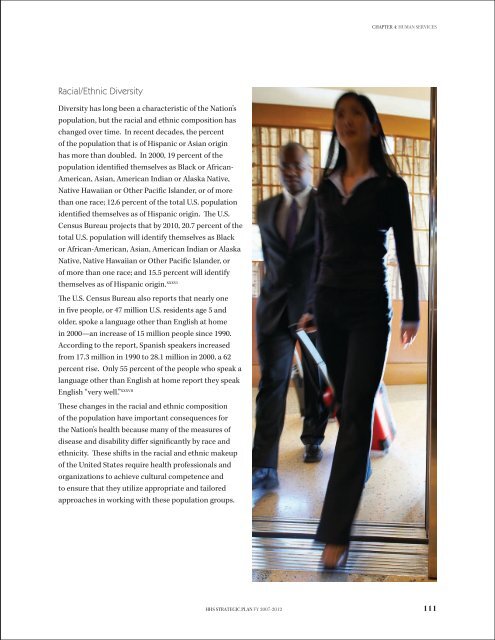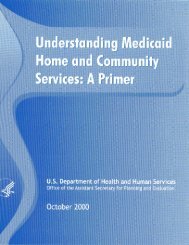CHAPTER 4: human servicesDemographic Changes <strong>and</strong> TheirImpact on <strong>Health</strong> <strong>and</strong> Well-BeingEfforts to improve the health <strong>and</strong> well-being <strong>of</strong>Americans over the next 5 years will be shaped byimportant changes in demographics. Our Nationis growing older <strong>and</strong> becoming more racially <strong>and</strong>ethnically diverse.Aging PopulationMore Americans are living longer, <strong>and</strong> the proportion<strong>of</strong> the Nation’s population that is age 65 or older isgrowing rapidly. A baby born in 2006 can expectto live to age 78. This age expectancy representsa gain <strong>of</strong> more than 10 years since 1965, when theOlder Americans Act <strong>of</strong> 1965 (Public Law 89-73) firstauthorized Medicare <strong>and</strong> Medicaid. From 1950 to2006, the total resident population <strong>of</strong> the United Statesdoubled from 150 million to more than 300 million.During this same period, the population 65 years <strong>of</strong> age<strong>and</strong> over grew twice as rapidly, increasing from 12 to 36million. According to projections from the U.S. CensusBureau, after the first Baby Boomers turn 65 in 2011,the number <strong>of</strong> older people will substantially increase.In 2030, the older population is anticipated to be twiceas large as in 2000, <strong>and</strong> will represent nearly 20 percent<strong>of</strong> the total U.S. population. xxxiiiThe aging <strong>of</strong> the population has importantimplications for health care, public health, <strong>and</strong>human service systems. As the older fraction <strong>of</strong> thepopulation increases, more services will be requiredfor the treatment <strong>and</strong> management <strong>of</strong> chronic <strong>and</strong>acute health conditions <strong>and</strong> disabilities. The average75 year old has three chronic conditions <strong>and</strong> usesfive different prescription drugs. xxxiv Today’s healthcare workforce lacks much <strong>of</strong> the training required toprovide appropriate care to today’s older adults <strong>and</strong>is thus unprepared for the projected increase in thenumber <strong>of</strong> older Americans over the next 20 years.Equally important, the health care workforce is olderthan in the past.Across the country, long-term care providers arefacing a shortage <strong>of</strong> qualified <strong>and</strong> committed directcare workers—those certified nursing assistants,home health aides, <strong>and</strong> personal care workers whoprovide h<strong>and</strong>s-on care to millions <strong>of</strong> older adults <strong>and</strong>individuals with disabilities. Over the next 10 years,the country will need an estimated 874,000 additionaldirect care workers to meet growing dem<strong>and</strong>. At thesame time, the supply <strong>of</strong> workers traditionally reliedupon to fill these positions—middle-aged women— willfall by about half by 2030. xxxvOlder Americans also have behavioral health <strong>and</strong>human service needs. Some older adults experiencelate onset <strong>of</strong> mental <strong>and</strong> addictive illnesses; othershave experienced them throughout their lives. Olderadults may experience depression <strong>and</strong> anxiety as theyface physical decline, death <strong>of</strong> family members <strong>and</strong>other loved ones, <strong>and</strong> increased limitations in normaldaily activities. In lieu <strong>of</strong> seeking treatment, someolder adults—as with other populations—may “selfmedicate”with alcohol. Further, older adults maymisuse prescription or over-the-counter medications,<strong>of</strong>ten inadvertently.The science <strong>of</strong> aging indicates that chronic disease<strong>and</strong> disability are not inevitable. As a result, healthpromotion <strong>and</strong> disease prevention activities <strong>and</strong>programs are an increasing priority for older adults,their families, <strong>and</strong> the health care system.110 HHS Strategic Plan FY 2007-2012
CHAPTER 4: human servicesRacial/Ethnic DiversityDiversity has long been a characteristic <strong>of</strong> the Nation’spopulation, but the racial <strong>and</strong> ethnic composition haschanged over time. In recent decades, the percent<strong>of</strong> the population that is <strong>of</strong> Hispanic or Asian originhas more than doubled. In 2000, 19 percent <strong>of</strong> thepopulation identified themselves as Black or African-American, Asian, American Indian or Alaska Native,Native Hawaiian or Other Pacific Isl<strong>and</strong>er, or <strong>of</strong> morethan one race; 12.6 percent <strong>of</strong> the total U.S. populationidentified themselves as <strong>of</strong> Hispanic origin. The U.S.Census Bureau projects that by 2010, 20.7 percent <strong>of</strong> thetotal U.S. population will identify themselves as Blackor African-American, Asian, American Indian or AlaskaNative, Native Hawaiian or Other Pacific Isl<strong>and</strong>er, or<strong>of</strong> more than one race; <strong>and</strong> 15.5 percent will identifythemselves as <strong>of</strong> Hispanic origin. xxxviThe U.S. Census Bureau also reports that nearly onein five people, or 47 million U.S. residents age 5 <strong>and</strong>older, spoke a language other than English at homein 2000—an increase <strong>of</strong> 15 million people since 1990.According to the report, Spanish speakers increasedfrom 17.3 million in 1990 to 28.1 million in 2000, a 62percent rise. Only 55 percent <strong>of</strong> the people who speak alanguage other than English at home report they speakEnglish “very well.” xxxviiThese changes in the racial <strong>and</strong> ethnic composition<strong>of</strong> the population have important consequences forthe Nation’s health because many <strong>of</strong> the measures <strong>of</strong>disease <strong>and</strong> disability differ significantly by race <strong>and</strong>ethnicity. These shifts in the racial <strong>and</strong> ethnic makeup<strong>of</strong> the United States require health pr<strong>of</strong>essionals <strong>and</strong>organizations to achieve cultural competence <strong>and</strong>to ensure that they utilize appropriate <strong>and</strong> tailoredapproaches in working with these population groups.HHS Strategic Plan FY 2007-2012111
















